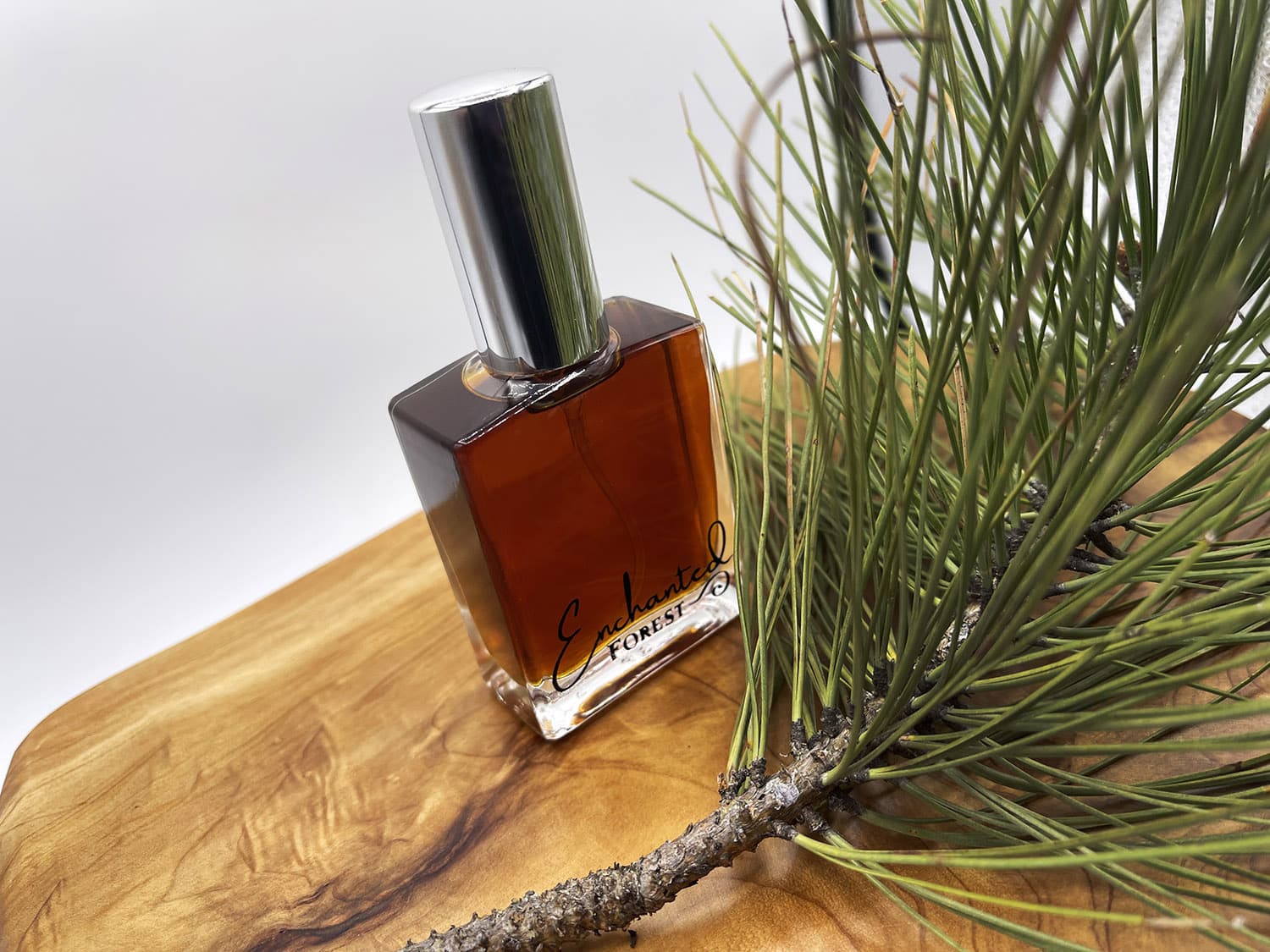I’m completely captivated by the scent of pine resin. It’s simply heavenly. Every time I work with my pine tar, I walk around smelling my hands like Mary Katherine Gallagher for the next couple of hours.

In aromatherapy, the resinous aroma of pine pitch is known for its uplifting and invigorating qualities, helping to improve mood and reduce stress. I can vouch for this effect… the smell of pine pitch makes me SO happy!
And while my precious pine tar is amazing for topical conditions like warts, splinters and all sorts of inflamed, irritated skin, it’s incredibly thick and sticky and just doesn’t lend itself to dabbing on your pulse points.
So I decided I needed (NEEDED) to make myself a pine pitch perfume.
From top to bottom
In perfumery, fragrances are categorized based on their volatility and how long they last on the skin. These categories of fragrances are referred to as top notes, middle notes and base notes.
To create a harmonious fragrance that evolves over time as its different notes are released, you need to choose at least one note from each category. A combination of top, middle and base notes create fragrances that are complex and long-lasting.
Base notes
Base notes provide the foundation of the fragrance and help to anchor the scent, giving it depth and longevity. They are typically the longest-lasting notes and have a heavier, more robust character. Some common base notes include frankincense, myrrh, sandlewood and… pine pitch.
Pine pitch has a rich resinous aroma that adds woody, balsamic and slightly smoky notes to a fragrance. Its resin also acts as a fixative, helping to slow the evaporation rate of other fragrance ingredients and prolonging the overall longevity of the fragrance blend (more on that later).
Middle notes
Middle notes, sometimes called ‘heart notes’, emerge as the top notes evaporate and provide the main body of the fragrance. They are the backbone of a fragrance, providing the body and fullness that support the lighter top notes and the longer-lasting base notes. Middle notes are typically floral or herbal in nature, with a warm, spicy, or woody character.
Common middle notes include lavender, cinnamon, rose and ylang-ylang.
Top notes
Top notes are the first impression of a fragrance and provide the initial burst of scent when the fragrance is first applied. They are typically lighter and more volatile, meaning they evaporate more quickly than other notes. As such, they are not meant to be the main focus of a fragrance but rather serve as an introduction to the longer-lasting and more substantive heart and base notes that follow.
Common top notes include anything citrusy such as bergamot or grapefruit, as well as herbaceous plants like basil and peppermint.
Top
- bergamot
- lemon
- lime
- orange
- grapefruit
- mandarin
- tangerine
- petitgrain
- lavender
- peppermint
- spearmint
- eucalyptus
- lemongrass
- basil
- rosemary
- sage
- thyme
- ginger
- cardamom
- black pepper
- pink pepper
Middle
- lavender
- rose
- jasmine
- ylang-ylang
- geranium
- clary sage
- neroli
- chamomile
- pine
- cedarwood
- sandalwood
- patchouli
- vetiver
- frankincense
- myrrh
- cinnamon
- nutmeg
- black pepper
- pink pepper
- ginger
- cardamom
Base
- sandalwood
- cedarwood
- patchouli
- vetiver
- frankincense
- myrrh
- benzoin
- vanilla
- labdanum
- oakmoss
- peru balsam
- rosewood
- pine
- amyris
- ginger
- clove
- cinnamon
- nutmeg
- black pepper
- cypress
- juniper
You may have noticed some overlap in the different note categories. Some scents can be used as both top and middle notes; others can function as both a middle and base note. A few chameleons such as black pepper can straddle all three categories. Classification depends on the concentration and the other ingredients used in the perfume blend.
For example, cardamom and ginger can both be used in lower concentrations to act as top notes with their sharp, spicy qualities, while in higher concentrations, they work as warm, aromatic and woody middle notes.
Likewise, frankincense and myrrh can be used at lower concentrations to act as middle notes with their woody, balsamic and slightly spicy qualities, while at higher concentrations, they work as resinous and earthy base notes.
Fixatives
Many commercial perfumes are made with synthetic fixatives. As the name suggests, fixatives enhance the longevity and staying power of a fragrance by helping to slow down the evaporation rate of fragrance ingredients, allowing the fragrance to last longer on the skin or in the air.
We can use a resin such as pine pitch to accomplish the same thing. Resins have been used for centuries as natural fixatives in fragrances. In addition to contributing terpenes and other aromatic compounds that have a long-lasting base notes of their own, resin can help to slow down the evaporation rate of other volatile compounds and bind the fragrance molecules to the skin, allowing the scent to last longer.
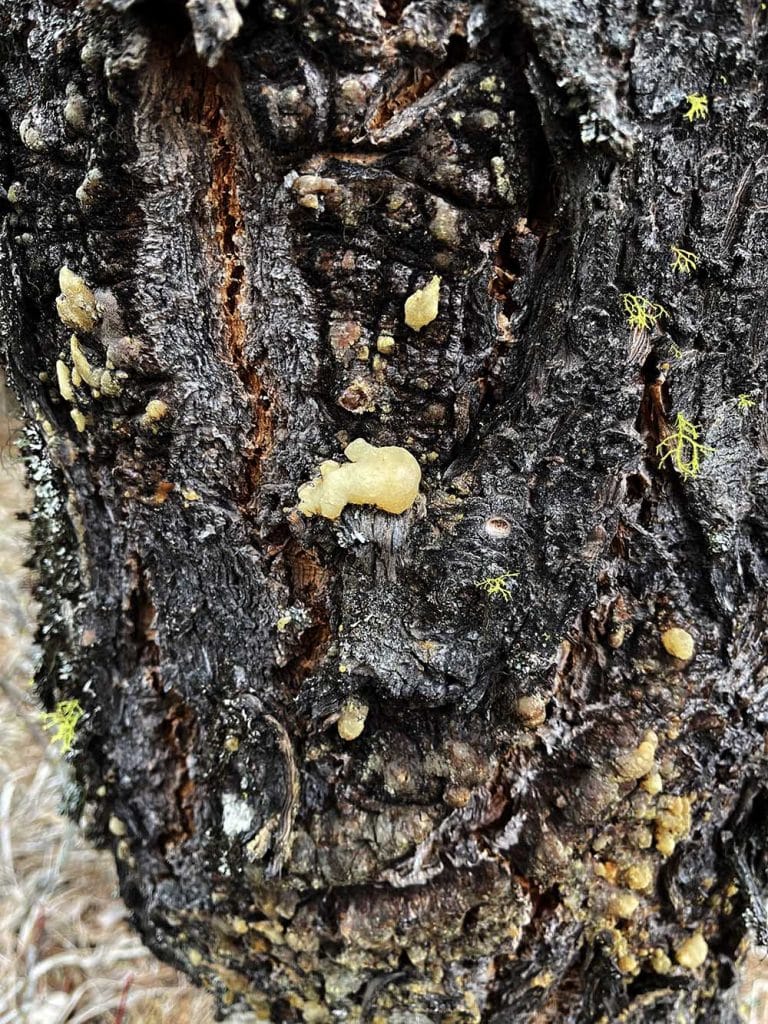
Working with pine pitch
To incorporate pine pitch into our perfume, we’ll need to make an alcohol tincture. Refer to my post Processing Pine Pitch for Use in Personal Care & Health Products for more info about the many uses for pine resin and how to collect it. (Spoiler: it’s stupid-easy.)
The exact composition of pine pitch varies depending on the species of pine, the season in which it was collected and other environmental factors, but generally, it’s made up of organic compounds including terpenes, resin acids, fatty acids and waxes. Some of these compounds like the terpenes and resin acids are soluble in high-proof alcohol, while the fatty acids and waxes are not soluble at all. That’s okay, it’s the fragrance and resin we’re after anyway! Terpenes are a constituent found in many essential oils and resins and are responsible for the distinct, piney aroma of our pine pitch. Resin acids are found in the resinous exudate of pines and coniferous trees and contribute to the adhesive properties of pine pitch (as well as its antiseptic and antimicrobial properties).
Making pine pitch tincture
Use the highest proof ethanol you can find. 100% perfumer’s alcohol is your best bet to dissolve the pine resin and extract its aromatic and fixative properties. While 190 proof (95%) neutral grain alcohol may also be effective at dissolving pine resin and other aromatic materials, its stronger alcohol odor can make it unsuitable for use in a perfume. Perfumer’s alcohol has been formulated to have a more neutral odor and ensures that the final fragrance smells clean and balanced without any unwanted alcohol notes.
Do not try to use isopropyl alcohol. The strong scent will overpower your fragrance, and I promise you will not be happy with the end product.
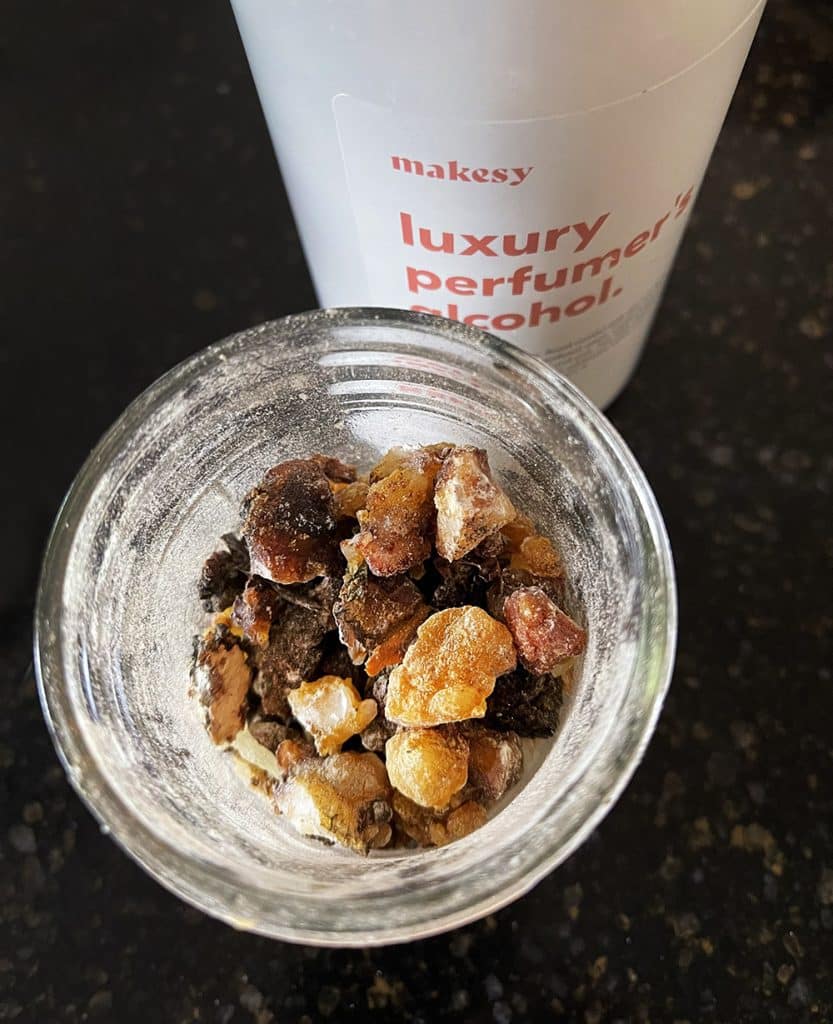
Even with a higher proof, you’ll still likely have trouble dissolving a big ol’ hunk of resin, so crush or grind the pine pitch into smallish pieces or even powder to help things along. As Suzanne Tabert would say, open ALL the doors and windows.
Fill a jar about 3/4 full of resin bits and pieces, cover with your alcohol of choice. Seal the jar and label: name of the contents, type of alcohol and the maceration start and end dates are all useful information. Store in a cool, dark place for a couple of weeks, shaking it every so often to encourage the alcohol to pull the resin and fragrance from the pine pitch.
After a week or two, inspect your resin tincture. Some types of pine resin may be less soluble in ethanol than others, and the solubility may also be affected by factors such as temperature and agitation frequency. If you find that your pine resin is not dissolving well, you may need to give it a bit more time and shake the jar more often.
When you’re happy with the strength of your pine resin tincture, strain to remove the solid pieces of pine pitch/resin, leaving behind the fragrant alcohol-based extract. You may need to do several passes or add a a layer of cheese cloth to your strainer to catch all of the plant matter.
Fine tuning your perfume
As we talked about in Scent-sational Science: Using Aromatherapy for Better Sleep, inexpensive paper testing strips are a helpful tool for developing a pleasing essential oil blend. Refer to the section on using paper testing strips to blend EOs for a refresher on the process.
Unlike synthetic fixatives, natural resins like pine pitch are very sticky. Too much resin and a spritz of your homemade perfume will leave an unpleasant sticky spot on your skin. The trick is to find a balance between diluting your pine resin tincture with enough alcohol to minimize the stickiness and leaving enough of the resin to impart the fragrance you want. I use a 50-50 dilution in this recipe, but you may need to adjust that depending on the strength and composition of your pine resin tincture.
My Enchanted Forest
Don’t forget to give your fragrance blend a name!
Mine is ‘Enchanted Forest’ which, to me, is suggestive of a magical, otherworldly scent. The pine pitch, sandlewood and black pepper give it a mysterious, seductive edge and the mandarin provides a bright, sparkling accent… just like an Enchanted Forest! ♥
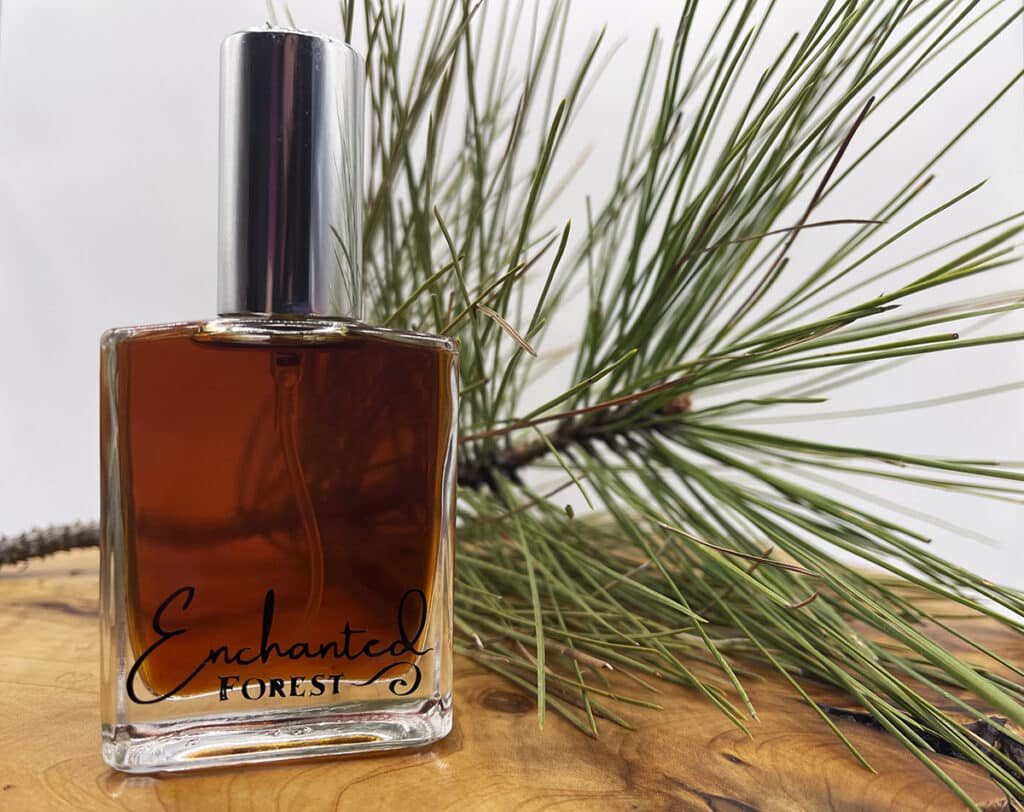
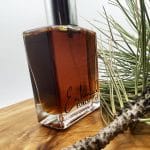
‘Enchanted Forest’ Pine Pitch Perfume
5 Stars 4 Stars 3 Stars 2 Stars 1 Star
No reviews
Ingredients
1 oz pine resin tincture (see Making Pine Pitch Tincture above)
1 oz perfumer’s alcohol
15 drops mandarin essential oil
8 drops black pepper essential oil
4 drops sandlewood essential oil
Instructions
- Make a concentrated pine resin tincture by filling a small glass mason jar about 3/4 full of pine resin bits and pieces. Don’t worry about dirt or bark in the tincture — they will be strained out later.
- Fill jar to the top with perfumer’s alcohol, cover, label and place jar in a cool, dark location for a week or so, shaking the jar every so often.
- When your pine resin tincture is done infusing, strain out any solids left in the jar.
- Combine ingredients in a fine mister bottle with a 2-oz capacity. You will likely need to dilute your pine resin tincture with additional perfumer’s alcohol. The concentrated tincture will probably be a bit sticky if you try to use it straight. Don’t worry, though — even diluted, plenty of that glorious pine resin fragrance will remain. ♥
Notes
Makes one 2-oz bottle of perfume.
Jars, tools and fingers that come in contact with the concentrated tincture will be sticky. They should clean up easily with a little isopropyl alcohol.

